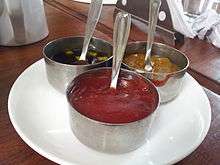Sauerkraut
Sauerkraut (/ˈsaʊ.ərkraʊt/; German: [ˈzaʊɐˌkʁaʊt] (![]()
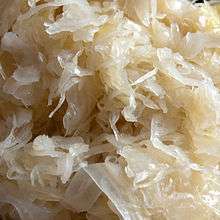
Overview and history
Fermented foods have a long history in many cultures, with sauerkraut being one of the most well-known instances of traditional fermented moist cabbage side dishes.[6] The Roman writers Cato (in his De Agri Cultura) and Columella (in his De re Rustica) mentioned preserving cabbages and turnips with salt.
Although "sauerkraut" is a German word, the dish did not originate in Germany. Some claim that the Mongol Emperor Genghis Khan brought it to Europe.[7] Others claim that it originally came from China and surrounding areas and that the Tatars brought it to Europe,[8] and altered the original Chinese recipe by fermenting it with salt instead of rice wine.[9] It took root mostly in Central and Eastern European cuisines, but also in other countries including the Netherlands, where it is known as zuurkool, and France, where the name became choucroute.[10] The English name is borrowed from German where it means literally "sour herb" or "sour cabbage".[11] The names in Slavic and other Central and Eastern European languages have similar meanings with the German word: "fermented cabbage" (Albanian: lakër turshi, Azerbaijani: kələm turşusu,[12] Belarusian: квашаная капуста, Czech: kysané zelí, Lithuanian: rauginti kopūstai, Polish: kiszona kapusta, Russian: квашеная капуста, tr. kvašenaja kapusta, Ukrainian: квашена капуста) or "sour cabbage" (Bulgarian: кисело зеле, Czech: kyselé zelí, Estonian: hapukapsas, Finnish: hapankaali, Hungarian: savanyúkáposzta, Latvian: skābēti kāposti, Polish: kiszona kapusta, Romanian: varză murată, Russian: кислая капуста, tr. kislaya kapusta, Serbo-Croatian: кисели купус / kiseli kupus, Slovak: kyslá kapusta, Slovene: kislo zelje, Ukrainian: кисла капуста, kisla kapusta).[13]
Before frozen foods, refrigeration, and cheap transport from warmer areas became readily available in northern, central and eastern Europe, sauerkraut – like other preserved foods – provided a source of nutrients during the winter. Captain James Cook always took a store of sauerkraut on his sea voyages, since experience had taught him it prevented scurvy.[14][15]
The word "Kraut", derived from this food, is a derogatory term for the German people.[16] During World War I, due to concerns the American public would reject a product with a German name, American sauerkraut makers relabeled their product as "Liberty Cabbage" for the duration of the war.[17]
Production
Sauerkraut is made by a process of pickling called lactic acid fermentation that is analogous to how traditional (not heat-treated) pickled cucumbers and kimchi are made. The cabbage is finely shredded, layered with salt, and left to ferment. Fully cured sauerkraut keeps for several months in an airtight container stored at 15 °C (60 °F) or below. Neither refrigeration nor pasteurization is required, although these treatments prolong storage life.
Fermentation by lactobacilli is introduced naturally, as these air-borne bacteria culture on raw cabbage leaves where they grow. Yeasts also are present, and may yield soft sauerkraut of poor flavor when the fermentation temperature is too high. The fermentation process has three phases, collectively sometimes referred to as population dynamics. In the first phase, anaerobic bacteria such as Klebsiella and Enterobacter lead the fermentation, and begin producing an acidic environment that favors later bacteria. The second phase starts as the acid levels become too high for many bacteria, and Leuconostoc mesenteroides and other Leuconostoc species take dominance. In the third phase, various Lactobacillus species, including L. brevis and L. plantarum, ferment any remaining sugars, further lowering the pH.[18] Properly cured sauerkraut is sufficiently acidic to prevent a favorable environment for the growth of Clostridium botulinum, the toxins of which cause botulism.[2][3]
A 2004 genomic study found an unexpectedly large diversity of lactic acid bacteria in sauerkraut, and that previous studies had oversimplified this diversity. Weissella was found to be a major organism in the initial, heterofermentative stage, up to day 7. It was also found that Lactobacillus brevis and Pediococcus pentosaceus had smaller population numbers in the first 14 days than previous studies had reported.[19]
The Dutch sauerkraut industry found that inoculating a new batch of sauerkraut with an old batch resulted in an excessively sour product. This sourdough process is known as "backslopping" or "inoculum enrichment"; when used in making sauerkraut, first- and second-stage population dynamics, important to developing flavor, are bypassed. This is due primarily to the greater initial activity of species L. plantarum.[20]
Regional varieties
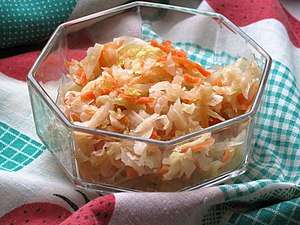
In Azerbaijani, Belarusian, Polish, Russian, Baltic states and Ukrainian cuisine, chopped cabbage is often pickled together with shredded carrots. Other ingredients may include whole or quartered apples for additional flavor or cranberry for flavor and better keeping (the benzoic acid in cranberries is a common preservative). Bell peppers and beets are added in some recipes for colour. The resulting sauerkraut salad is typically served cold, as zakuski or a side dish. A home made type of very mild sauerkraut is available, where white cabbage is pickled with salt in a refrigerator for only three to seven days. This process results in very little lactic acid production. Sometimes in Russia the double fermentation is used, with the initial step producing an exceptionally sour product, which is then "corrected" by adding 30-50% more fresh cabbage and fermenting the mix again. The flavor additives like apples, beets, cranberries and sometimes even watermelons are usually introduced at this step.
Sauerkraut may be used as a filling for Polish pierogi, Ukrainian varenyky, Russian pirogi and pirozhki.[21] Sauerkraut is also the central ingredient in traditional soups, such as shchi (a national dish of Russia), kwaśnica (Poland), kapustnica (Slovakia), and zelňačka (Czech Republic). It is an ingredient of Polish bigos (a hunter's stew). Bigos (Hunter's Stew)
In Germany, cooked sauerkraut is often flavored with juniper berries[22] or caraway seeds; apples and white wine are added in popular variations. Traditionally it is served warm, with pork (e.g. eisbein, schweinshaxe, Kassler) or sausages (smoked or fried sausages, Frankfurter Würstchen, Vienna sausages, black pudding), accompanied typically by roasted or steamed potatoes or dumplings (knödel or schupfnudel).[23] Similar recipes are common in other Central European cuisines. The Czech national dish vepřo knedlo zelo consists of roast pork with knedliky and sauerkraut.
In France, sauerkraut is the main ingredient of the Alsatian meal choucroute garnie (French for "dressed sauerkraut"), sauerkraut with sausages (Strasbourg sausages, smoked Morteau or Montbéliard sausages), charcuterie (bacon, ham, etc.), and often potatoes.
Sauerkraut, along with pork, is eaten traditionally in Pennsylvania on New Year's Day. The tradition, started by the Pennsylvania Dutch, is thought to bring good luck for the upcoming year.[24] Sauerkraut is also used in American cuisine as a condiment upon various foods, such as sandwiches and hot dogs.[4][5][25] In Maryland, particularly in Baltimore and on the Eastern Shore, sauerkraut is a traditional accompaniment for the Thanksgiving turkey.[26]
 Cooked sauerkraut
Cooked sauerkraut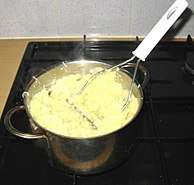
- Pierogi with sauerkraut
- Kapuśniak made with sauerkraut
.jpg) Central European-style sauerkraut and sausages is a popular snack dish in pubs.
Central European-style sauerkraut and sausages is a popular snack dish in pubs.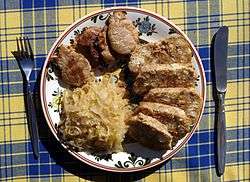 Czech Vepřo-knedlo-zelo
Czech Vepřo-knedlo-zelo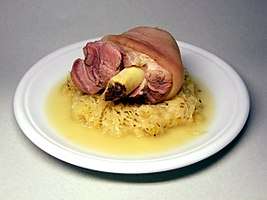 Pickled Eisbein served with sauerkraut
Pickled Eisbein served with sauerkraut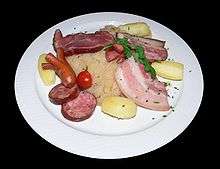 Alsatian Choucroute garnie
Alsatian Choucroute garnie
Health effects
Benefits
| Nutritional value per 100 g (3.5 oz) | |
|---|---|
| Energy | 78 kJ (19 kcal) |
4.3 g | |
| Sugars | 1.8 g |
| Dietary fiber | 2.9 g |
0.14 g | |
0.9 g | |
| Vitamins | Quantity %DV† |
| Vitamin B6 | 10% 0.13 mg |
| Vitamin C | 18% 15 mg |
| Vitamin K | 12% 13 μg |
| Minerals | Quantity %DV† |
| Iron | 12% 1.5 mg |
| Sodium | 44% 661 mg |
| Other constituents | Quantity |
| Water | 92 g |
| |
| †Percentages are roughly approximated using US recommendations for adults. Source: USDA Nutrient Database | |
Many health benefits have been claimed for sauerkraut:
- It is a high source of vitamins C and K;[27] the fermentation process increases the bioavailability of nutrients rendering sauerkraut even more nutritious than the original cabbage.[28] It is also low in calories and high in calcium and magnesium, and it is a very good source of dietary fiber, folate, iron, potassium, copper and manganese.[27]
- If unpasteurized and uncooked, sauerkraut also contains live lactobacilli and beneficial microbes and is rich in enzymes. Fiber and probiotics improve digestion and promote the growth of healthy bowel flora, protecting against many diseases of the digestive tract.[28][29]
- During the American Civil War, the physician John Jay Terrell (1829–1922)[30] was able to successfully reduce the death rate from disease among prisoners of war; he attributed this to feeding his patients raw sauerkraut.[31]
- Sauerkraut and its juice is a time-honored folk remedy for canker sores. The treatment is to rinse the mouth with sauerkraut juice for about 30 seconds several times a day, or place a wad of sauerkraut against the affected area for a minute or so before chewing and swallowing the sauerkraut.[32]
- In 2002, the Journal of Agriculture and Food Chemistry reported that Finnish researchers found the isothiocyanates produced in sauerkraut fermentation inhibit the growth of cancer cells in test tube and animal studies.[33] A Polish study in 2010 concluded that "induction of the key detoxifying enzymes by cabbage juices, particularly sauerkraut, may be responsible for their chemopreventive activity demonstrated by epidemiological studies and in animal models".[34][35][36][37][38][39][40][41]
- Sauerkraut is high in the antioxidants lutein and zeaxanthin, both associated with preserving ocular health.[42]
Disadvantages
Excessive consumption of sauerkraut may lead to bloating and flatulence due to the trisaccharide raffinose, which the human small intestine cannot break down. This does not negatively affect long-term health, although it might be uncomfortable.[43]
Scientific discovery
One of the early scientists who was involved in identifying the biology and function of Clustered Regularly Interspaced Short Palindromic Repeats (CRISPR), Philippe Horvath, focused on the genetics of a lactic-acid bacterium used in the production of sauerkraut.[44]
Similar foods
Many other vegetables are preserved by a similar process:
- Kapusta kiszona in Poland
- Encurtido in Nicaragua
- Atsara in the Philippines
- Curtido in El Salvador
- Dill pickles in eastern and central Europe
- Kimchi in Korea
- Whole sour cabbage in Romania, Serbia, Bosnia, Croatia, and Bulgaria
- Silage, a feed for cattle
- Suan cai in northeastern China
- Tsukemono in Japan
- Brovada in Northern Italy
See also
- Foods containing tyramine
- List of ancient dishes and foods
- List of cabbage dishes – Wikipedia list article
- List of fermented foods – Wikipedia list article
- Suan cai – Traditional Chinese pickled vegetables
- Whole sour cabbage – A fermented vegetable preserve, popular in Romanian, Bosnian, Croatian, Macedonian, Serbian and Bulgarian cuisines
References
- "Online Etymology Dictionary". https://www.etymonline.com/search?q=sauerkraut. Retrieved 27 January 2018.
- Farnworth, Edward R. (2003). Handbook of Fermented Functional Foods. CRC. ISBN 978-0-8493-1372-1.
- "Fermented Fruits and Vegetables - A Global SO Perspective". United Nations FAO. 1998. Retrieved 10 June 2007.
- Gil Marks. Encyclopedia of Jewish Food. p. 1052.
- Joseph Mercola, Brian Vaszily, Kendra Pearsall, Nancy Lee Bentley. Dr. Mercola's Total Health Cookbook & Program. p. 227.
- Wendy Brown (2011). Surviving the Apocalypse in the Suburbs: The Thrivalist's Guide to Life Without Oil. New Society Publishers. p. 60. ISBN 978-1-55092-471-8. Retrieved 11 July 2013.
- The History of Sauerkraut, The Kitchen Project
- Sauerkraut in a crock. Originally from China, sauerkraut can be made fresh at home, Christian Science Monitor
- Sauerkraut: It All Began in China, New York Times
- Gazette, The (22 September 2007). "Sauerkraut rises above its humble origins". Canada.com. Archived from the original on 26 August 2012. Retrieved 9 February 2012.
- The German for cabbage is Kohl, while Kraut means "herb". However the latter also means cabbage in such words as Sauerkraut, Weißkraut (white cabbage), etc.
- "Kələm turşusu". 1001dad (in Azerbaijani). 11 November 2014. Archived from the original on 14 April 2016. Retrieved 20 April 2019.
- "Sauerkraut - Sauerkraut Is the Quintessential Eastern European Vegetable - all About Sauerkraut". Easteuropeanfood.about.com. 12 June 2010. Retrieved 9 February 2012.
- see http://www.mariner.org/exploration/index.php?type=webpage&id=55 / What did they eat? which begins "One of Cook's most important discoveries..." and http://www.vitamindeficiency.info/?page_id=9 which additionally mentions "...citrus fruit such as lemons and lime. James Cook ...."
- Saloheimo P (2005). "[Captain Cook used sauerkraut to prevent scurvy]". Duodecim (in Finnish). 121 (9): 1014–5. PMID 15991750.
- Oxford English Dictionary. Second edition, 1989. "1. = SAUERKRAUT, SOURCROUT. Also attrib. and Comb. 2. (Often with capital initial.) A German, esp. a German soldier. Also attrib. and Comb. Derogatory."
- "Sauerkraut may be 'Liberty Cabbage'" (PDF). The New York Times. 25 April 1918. Retrieved 16 January 2011.
- The pH of completely cured sauerkraut is about 3.6; see Belitz, H.-D.; Grosch, Werner; Schieberle, Peter (2009). Food Chemistry (4th Edition). Springer. p. 803. ISBN 9783540699330.
- F. BREIDT, JR. (2004). "A Genomic Study of Leuconostoc mesenteroides and the Molecular Ecology of Sauerkraut Fermentations" (PDF). Journal of Food Science. 69 (1): 30–33. doi:10.1111/j.1365-2621.2004.tb17874.x. Archived from the original (PDF) on 16 September 2012. Retrieved 19 January 2011.
- National Research Council (US) Panel on the Applications of Biotechnology to Traditional Fermented Foods (1992). Applications of biotechnology to traditional fermented foods: report of an ad hoc panel of the Board on Science and Technology for International Development. Washington, D.C: National Academy Press. pp. 15–45. doi:10.17226/1939. ISBN 978-0-309-04685-5. PMID 25121339. Retrieved 19 January 2011.
- "Pierogi - the best guide to the most popular Polish food". www.tastingpoland.com.
- Mimi Sheraton. The German Cookbook: A Complete Guide to Mastering Authentic German Cooking. p. 435.
- "Meet the Germans – Typically German - The Germans and ... - Sauerkraut - Goethe-Institut". Goethe.de. Retrieved 13 April 2013.
- "Sauerkraut on New Year's a Pennsylvania tradition". TimesUnion.com. 31 December 2009. Retrieved 1 January 2013.
- Ross, Sylvia (24 April 2001). "Allergy Cuisine: Step by Step". iUniverse – via Google Books.
- Pitts, Jonathan. "Sauerkraut and turkey: an essential Baltimore Thanksgiving". baltimoresun.com.
- "Nutrition Facts". Retrieved 11 June 2015.
- Lipski, Elizabeth (2013). "6". Digestion Connection: The Simple, Natural Plan to Combat Diabetes, Heart Disease, Osteoporosis, Arthritis, Acid Reflux--And More!. Rodale. p. 63. ISBN 978-1609619459.
- Martina Watts. "Fancy Some Sauerkraut?". TheHealthBank. Retrieved 11 June 2015.
- Haggard, Robert F (1998). "Samuel Miller and the Founding of the Miller School of Albemarle". The Magazine of Albemarle County History. 56 (53–76): 62.
- Ward, Jessica B. 2004. Food to Die for: A Book of Funeral Food, Tips and Tales from the Old City Cemetery, Lynchburg, Virginia. Lynchburg, VA: Southern Memorial Association, pp. 149–150.
- "Sauerkraut as a remedy for canker sores". Los Angeles Times. 15 February 2010. Retrieved 15 April 2013.
- EurekAlert (2002). "Sauerkraut contains anticancer compound".
- Krajka-Kuźniak, V; Szaefer, H; Bartoszek, A; Baer-Dubowska, W (25 March 2013). "Modulation of rat hepatic and kidney phase II enzymes by cabbage juices: comparison with the effects of indole-3-carbinol and phenethyl isothiocyanate". Br J Nutr. 105 (6): 816–26. doi:10.1017/S0007114510004526. PMID 21092375.
- Moret, Sabrina; Smela, Dana; Populin, Tiziana; Conte, Lanfranco S.; et al. (2005). "A survey on free biogenic amine content of fresh and preserved vegetables". Food Chemistry. 89 (3): 355–361. doi:10.1016/j.foodchem.2004.02.050.
- Pu, C.; Xia, C; Xie, C; Li, K; et al. (November 2001). "Research on the dynamic variation and elimination of nitrite content in sauerkraut during pickling". Wei Sheng Yan Jiu. 30 (6): 352–4. PMID 12561618.
- Wantke, F.; Götz, M; Jarisch, R; et al. (December 1993). "Histamine-free diet: treatment of choice for histamine-induced food intolerance and supporting treatment for chronic headaches". Clinical & Experimental Allergy. 23 (12): 982–5. doi:10.1111/j.1365-2222.1993.tb00287.x. PMID 10779289.
- Ward, Mary H.; et al. (June 2000). "Dietary exposure to nitrite and nitrosamines and risk of nasopharyngeal carcinoma in Taiwan". International Journal of Cancer. 86 (5): 603–9. doi:10.1002/(SICI)1097-0215(20000601)86:5<603::AID-IJC1>3.0.CO;2-H. PMID 10797279. Archived from the original on 16 December 2012.
- Chang, Ellen T.; Hans-Olov Adami (October 2006). "The Enigmatic Epidemiology of Nasopharyngeal Carcinoma". Cancer Epidemiology, Biomarkers & Prevention. 15 (10): 1765–77. doi:10.1158/1055-9965.EPI-06-0353. PMID 17035381.
- Hung, Hsin-chia; Huang, MC; Lee, JM; Wu, DC; Hsu, HK; Wu, MT; et al. (June 2004). "Association between diet and esophageal cancer in Taiwan". Journal of Gastroenterology and Hepatology. 19 (6): 632–7. doi:10.1111/j.1440-1746.2004.03346.x. PMID 15151616.
- Siddiqi, Maqsood; R. Preussmann (1989). "Esophageal cancer in Kashmir – an assessment". Journal of Cancer Research and Clinical Oncology. 115 (2): 111–7. doi:10.1007/BF00397910. PMID 2715165.
- "Ten Reasons to Eat Fresh Unpasteurized Sauerkraut". Retrieved 11 June 2015.
- St. John, Tina (5 June 2011). "Can You Eat Too Much Sauerkraut?". Livestrong.com. Retrieved 24 June 2013.
- Lander, Eric S. (14 January 2016). "The Heroes of CRISPR". Cell. 164 (1–2): 18–28. doi:10.1016/j.cell.2015.12.041. ISSN 1097-4172. PMID 26771483.
Bibliography
- USDA Canning guides, Volume 7
- "rec.foods.preserving FAQ". Retrieved 23 April 2006.
- Aubert, Claude (1999). Keeping Food Fresh: Old World Techniques & Recipes. Chelsea Green Publishing Company. ISBN 978-1-890132-10-1.
- Fallon, Sally, with Enig, Mary G., PhD (2001). Nourishing Traditions...[westonaprice.org; newtrendspublishing.com]. New Trends Publishing. ISBN 978-0-9670897-3-7.
- Katz, Sandor Ellix (2003). Wild Fermentation: The Flavor, Nutrition, and Craft of Live-Culture Foods. Chelsea Green Publishing Company. ISBN 978-1-931498-23-4. Retrieved 23 April 2006.
- Kaufmann, Klaus (2001). Making Sauerkraut and Pickled Vegetables at Home. Book Publishing Company. ISBN 978-1-55312-037-7. Archived from the original on 28 June 2009.
External links
| Wikibooks Cookbook has a recipe/module on |
| Look up sauerkraut in Wiktionary, the free dictionary. |
| Wikimedia Commons has media related to Sauerkraut. |
